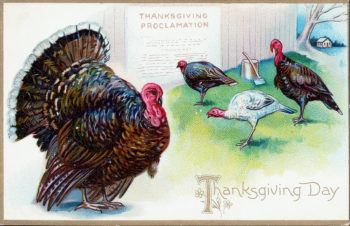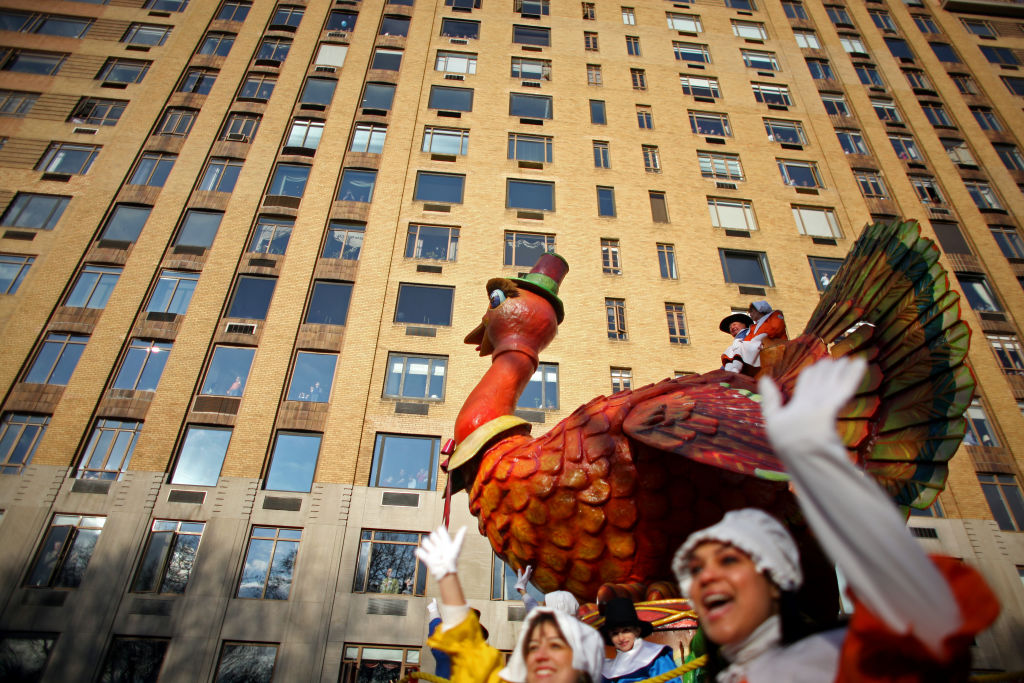Parade participants lead a turkey float during the annual Macy’s Thanksgiving Day Parade in New York City.
Yana Paskova/Getty Images
Have you ever wondered why Thanksgiving revolves around turkey and not ham, chicken, venison, beef or corn?
Nearly 9 out of 10 Americans eat turkey at this festive meal, whether roasted, fried, grilled or cooked in any other way for the occasion.
You might think it was because of what the Pilgrims, a year after landing in what is now the state of Massachusetts, and their native Wampanoag guests ate at their first thanksgiving feast. in 1621. Or that it’s because the turkey originated in the Americas.
But that has more to do with how Americans observed the holiday in the late 1800s than it did with the fowl Pilgrims ate while celebrating their generosity in 1621.
Did they eat it or not?
The only first-hand record of what pilgrims ate on the first thanksgiving feast comes from Edward Winslow. He noted that the Wampanoag chief, Massasoit, arrived with 90 men and the two communities feasted together for three days.
Winslow wrote little about the menu, other than mentioning five deer the Wampanoag brought and that the meal included “hen”, which could have been any number of wild birds found in the area, including ducks, geese and turkeys.
Historians know that important ingredients in today’s traditional dishes were unavailable on that first Thanksgiving.
This includes potatoes and green beans. The likely absence of wheat flour and the scarcity of sugar in New England at the time ruled out pumpkin pie and cranberry sauce. Some kind of squash, a staple of Native American diets, was almost certainly served, along with corn and shellfish.

Turkeys have always been an integral part of holiday marketing.
Photo Archive/Getty Images
A revived tradition
Historians like me who have studied the history of food have found that most modern Thanksgiving traditions began in the mid-19th century, more than two centuries after the first Pilgrim harvest celebration.
The reimagining of the Pilgrim Celebration as a national holiday is largely the work of Sarah Hale. Born in New Hampshire in 1784, as a young widow, she published poetry for a living. Most notably, she wrote the nursery rhyme “Mary Had a Little Lamb”.
In 1837 Hale became the publisher of the popular magazine Godey’s Lady’s Book. Fiercely religious and family-oriented, he led a crusade for the creation of an annual national holiday of “Thanksgiving and Praise” commemorating the Pilgrims’ holiday of thanksgiving.
Hale and his colleagues relied on the 1621 tradition for historical justification. Like many of her contemporaries, she assumed that the Pilgrims ate turkey at their first feast because of the abundance of edible wild turkeys in New England.
This campaign lasted for decades, in part because of a lack of enthusiasm among Southern whites. Many considered an earlier celebration among Virginia settlers honoring the supply ships that arrived in Jamestown in 1610 to be the most important precedent.
The absence of Southerners from Congress during the Civil War allowed President Abraham Lincoln to declare Thanksgiving a national holiday in 1863.

File photo circa 1955 of a family praying before the Thanksgiving meal, with a turkey as the centerpiece.
Evans/Three Lions/Getty Images
Marketing campaign for Turkey
Godey’s, along with other outlets, embraced the holiday, filling their pages with New England recipes and menus featuring turkey.
“We dare say that the greater part of Thanksgiving will take the form of a gastronomic pleasure,” predicted Augusta Chronicle in Georgia in 1882. “Anyone who can afford to buy turkey or s’ to procure it today will sacrifice the noble American fowl.”
One reason for that: a roast turkey makes a perfect centerpiece for celebrations.
A second is that the turkey is also convenient for serving a large crowd. Turkeys are larger than other birds raised or hunted for their meat, and it is cheaper to produce a turkey than a cow or pig. The attributes of the bird led Europeans to incorporate turkeys into their diet following their colonization of the Americas. In England, King Henry VIII regularly ate turkey on Christmas Day a century before the Pilgrims’ Day.
Christmas connection
The bird cemented its position as England’s favorite Christmas dish in the mid-19th century.
One of the reasons for this was that Ebenezer Scrooge in Charles Dickens’ “A Christmas Carol” sought to redeem himself by replacing the skinny goose of the impoverished Cratchit family with a huge turkey.
Published in 1843, Dickens’ instantly best-selling depiction of the praying family meal would soon inspire Hale’s idealized Thanksgiving.
Although historical records are hazy, I believe it is possible that Pilgrims ate turkey in 1621. It was certainly served at celebrations in New England throughout the colonial period.

